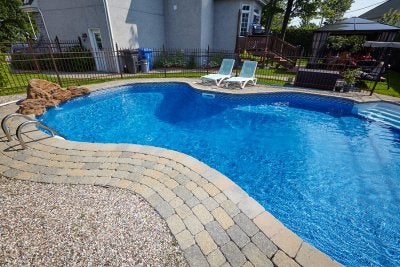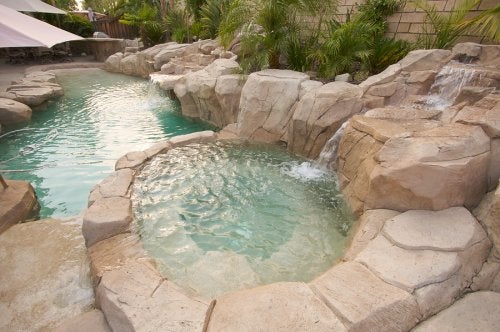-
Waterfalls: The Feature You Didn’t Know You Needed for Your New Pool
Your new swimming pool should be your own private sanctuary. It’s where you’ll go to relax and ignore the rest of the world for a little while. So why not take it a step further by adding a feature that epitomizes peace and tranquility? Waterfalls are a surprisingly affordable addition to any home swimming pool installation in Salt Lake City. Even if your in-ground pool has already been installed, you can still get back in touch with the pool contractor to inquire about adding a waterfall.
Meditative Sounds

The pleasant sounds of babbling brooks and cascading waterfalls are frequently the stars of musical arrangements intended for meditation. Even if you aren’t interested in meditating, there’s no question that the soothing sounds of your own private waterfall at your swimming pool can help you unwind from the stress of daily life.Visual Aesthetics
Your poolside waterfall can be custom designed and built to your exact preferences. It can be as simple or complex as you wish. Some families love the clean lines of sleek, modern design, while others prefer the natural look of rough-hewn stone. If you plan to construct a tall, expansive waterfall of natural stone, you could have the water directed to flow gracefully off multiple levels.
Leisurely Recreation
Any child who loves to swim will enjoy ducking through a beautiful waterfall—after all, a backyard waterfall far surpasses running through a sprinkler in the backyard. Plus, any pool party your child decides to host will be sure to be a success.
Natural Filtration
Waterfalls are the height of poolside luxury, but they also offer practical benefits. They churn the water continuously, which supports the pool’s filtration system. A waterfall is also an algae deterrent, as algae is more apt to accumulate in still water.
Installation Enhancements
Your poolside waterfall can be as unique as your own sense of style. Consider adding some enhancements to it, as well. If you’ve chosen natural stone for your waterfall, you might add a small stone staircase at one side of the waterfall to provide access to a slide on the other side. Add some dwarf shrubs for greenery, or consider adding a fire feature nearby.
-
Are You Backwashing Your Sand Filter Properly?
Swimming pool companies in Salt Lake City recommend backwashing the sand filter about every week, or more frequently if your pool gets a great deal of use. Ideally, you should do this pool maintenance task right after you vacuum your pool. Watch this quick video for a demonstration of the proper way to backwash a sand filter.
This pool maintenance expert directs viewers to turn off the sand filter, and then affix the backwash hose to the backwash nozzle. Screw on a hose clamp, and adjust the multiport valve from the filter setting to the backwash setting. It should run for about a minute. Then, you’ll adjust the setting to rinse, and finally turn the setting to filter. Once you’ve completed these steps, your lap pool is ready for use again.
-
Making Your Pool Safe for Diving
These days, many pool owners have decided to eliminate the diving board entirely. This is primarily due to safety concerns, although some people choose to avoid diving boards for aesthetic reasons. Diving can still be a thrilling part of the home pool experience, however, as long as you inform the swimming pool builder in Salt Lake City that you intend to use it for this purpose. Your pool contractor will discuss applicable safety codes with you to ensure your pool meets the safety standards.
Pool Length and Width

A pool will only be safe to dive in if it meets the minimum length and width standards. The American National Standard for Residential In-Ground Swimming Pools requires that all home pools with a diving board be at least 16 feet wide and 32 feet long.
Pool Depth
Depth is a crucial consideration for diving pools. At the deep end where the diving board will be installed, the pool must have a hopper that is at least eight feet deep. The hopper is the deepest part of the pool. However, competitive divers should ideally have a deeper pool for safety. Your pool contractor will let you know what the maximum depth available is.
Wall Slopes
Slope is another significant safety consideration. The code for residential pools prohibits wall slopes greater than a 1:5 slope ratio to a transition point. This transition point shouldn’t be any less than two feet, nine inches beneath the waterline.
Diving Boards
The diving board you select depends in part on the type of pool you have. If you have a saltwater pool, you’ll need a diving board that is capable of resisting rust. It’s possible to have a board as long as 10 feet if your pool is large and deep enough, but generally, only competitive divers would select a board this long. Most pool owners install a six-foot or eight-foot diving board, depending on the size of the pool.
Safety Rules
Your swimming pool builders can make your diving pool as safe as possible, but a good design and solid construction don’t override the need for consistently enforced safety rules. Divers should only jump off the end of the board, not the side, and no horseplay should be tolerated on or near the diving equipment. Children should have adult supervision at all times, and no one should swim or dive without a buddy present.
-
Using Pool Test Strips
Your indoor swimming pool near Salt Lake City relies on a delicate balance of chemicals that will keep the water clean, healthy, and comfortable for swimming. Once you’ve finished up the pool installation process, you’ll need to be able to tell how balanced the chemicals in your water are. Watch this video for some tips on using pool test strips.
Part of swimming pool maintenance is testing the chemical levels to make sure they’re in balance. You can do this using pool test strips. Your test strip will have a couple of readers for different chemicals, and you can match them up against the chart on the back of the container to see if they are in the safe range. Dip your entire test strip under the water for a couple of seconds, compare it to the chart, and then adjust your levels accordingly to enjoy a safe, healthy, and clean pool.
-
Keeping Pests Out of Your Pool
For many people, it’s tough to beat relaxing in the pool on a summer day. When pests decide to take over your pool, however, it can be hard to relax. Regular pool maintenance near Salt Lake City keeps your water clean, healthy, and refreshing, but how do you keep bugs out? Make sure you use a pool cover during the offseason so you don’t create a breeding ground for pest problems, do away with places pests can hide, and think about putting up a fence around your in-ground pool. Read ahead for details on these helpful tips.

Use a Pool Cover
When you close your pool up for the season, you might forget about it altogether until the warm weather rolls around again. If you want to make sure that pests don’t make themselves at home in your pool, it’s a good idea to close it up with a cover. Pool covers will seal out insects, rodents, and other pests that might otherwise set up habitats and start families in or around your pool. A cover can help, but you need to find one that fits your pool and install it properly.
Get Rid of Hiding Spots
Pool covers can be helpful, but they’re typically only used during the offseason. When there’s still plenty of time before you close yours up for the year, you’ll need to take additional steps to keep pests away. When you’re going through your swimming pool maintenance routine, make sure to keep an eye out for places where pests might be hiding. Bushes and growth around your pool can serve as habitats for pests and make it easy for them to spread into your pool, so get rid of these potential hiding spots.
Install a Fence
Pool fences can help keep children and pets safe, and they can also keep pests away from your swimming pool. Look for a fencing style that will do an adequate job of keeping small critters away—wood and vinyl fences may be ideal materials for a job like this. Choose a fence that doesn’t leave any room to sneak by.
-
Exploring Your Options for Swimming Pool Shapes
When it comes down to choosing a shape for your new swimming pool installation serving Salt Lake City , you can use a couple of key factors to make the right decision. Think about the size of your yard and how much of it you’d like to dedicate to your in-ground pool. You should also decide if you’d like your pool to be the same depth throughout, or if you would like a deep end and a shallow end. Then consider how you plan on using your pool, and decide what shape makes the most sense. Keep reading and explore your options for swimming pool shapes.
L-Shaped

Some homeowners look at swimming pool installations as a reasonable first investment after purchasing a house and starting a family. If you’re looking for something that your kids can enjoy during any stage of development, consider the benefits of an L-shaped pool. This layout typically features a distinct shallow end and deep end. This is helpful because it eliminates confusion and makes it clear where the water will be deeper, which is nice for kids who are still learning how to swim.
Rectangular
Much like an L-shaped swimming pool installation, a rectangular pool can include a shallow end and a deep end. This shape lends itself to a more seamless transition, however, where the floor gradually dips deeper as you move across the pool. If an L-shaped pool doesn’t make sense given the layout of your backyard, you might be able to accomplish the same goals with a rectangular design. This is a common and versatile design option for new swimming pool installations, and it can be great for everything from swimming laps to playing games with the family.
Freeform
If you have a yard that is shaped somewhat awkwardly, you might need a truly custom pool to meet your needs. Freeform pools can take on just about any shape you desire, making them able to fit into any environment necessary. If you want a completely unique swimming pool installation, you might want to talk to your pool professionals about a freeform design.
-
Troubleshooting Problems with Your Swimming Pool
If you can’t wait to dive into your backyard swimming pool for the first time this summer, the last thing that you will want to discover is that your pool is having unexpected maintenance problems. A pool contractor who offers swimming pool maintenance near Salt Lake City can help you get to the bottom of what is causing problems in your outdoor or indoor swimming pool. Here are some tips that will help you troubleshoot problems with your swimming pool.
Algae Growth

Algae growth can be a common problem when you open up your pool for the first time during the summer season. To pinpoint the cause of your algae growth, you can look at its color and typical growth pattern. Green algae is typically caused by an improper balance of chemicals in your pool water. If your algae growth is black or yellowish in color, the problem may be the result of a bad circulation flow in your pool pump.
Water Discoloration
Along with algae growth, there are a few other common causes of water discoloration in your swimming pool. If your pool water looks milky or cloudy, your pool may be experiencing a buildup of copper or other types of minerals. Typically, water discoloration can be cleared up by fixing or replacing the pool filter and by correcting the chemical balance in your pool water.
Surface Damage
Along with looking for signs of problems in your swimming pool water, you should check the surface of your pool for signs of damage. Surface damage can appear as etches, cracks, or wrinkles in your swimming pool tile or liner. When chemicals have been added incorrectly, the surface of your swimming pool materials may become bleached or otherwise discolored. In order to correct damage to the surface of your swimming pool, you will typically need to consult with your swimming pool contractor to schedule professional maintenance procedures.
-
When to Cover Your Pool or Spa
Pool covers are designed to protect pools when they are not actively in use. After you complete your swimming pool installation near Salt Lake City, your pool contractor may recommend that you purchase and use a cover for your new pool. By getting in the habit of covering your pool when you are not using it, you can prevent the need for extensive swimming pool services or repairs in the future.
There are a few instances when you will definitely want to cover your swimming pool. Your pool cover should be used during the winter season if you decide to not drain your pool. By covering up your pool over the winter months, you can prevent damage to your swimming pool filter and heater. Your pool cover will also keep leaves and debris out of your pool area. If you are a parent of young children, you should also cover up your pool to prevent your kids from accidentally falling into the pool if they are unattended.

-
The Benefits of Freeform Pool Designs
When you start to plan out your swimming pool installation with your pool builders, you will have the option of creating a freeform design for your pool area. Unlike traditional swimming pools, which contain rigid, geometric shapes, freeform pools have an organic look and feel. A builder that has plenty of experience with pool installation in Salt Lake City will be able to help you plan out a freeform pool that matches beautifully with your backyard.
There are a few terrific benefits to freeform swimming pool installation. When you create a freeform pool, you will be able to create a one-of-a-kind design for your backyard. Small pools are particularly suited to freeform design, as they can be crafted to look like natural water elements . You may also find that your swimming pool maintenance requirements are lower when you create a freeform design. Overall, planning a freeform pool will allow you to express your personality and sense of style.

-
Maintaining Your Pool in the Off-Season
During the off-season, it is crucial to maintain your pool, whether you are using it during the winter months or not. Even if you use your pool heater or have an indoor swimming pool near Salt Lake City, the tips found in the attached video will prove helpful. Continue reading to learn more about maintaining your pool during the off-season.
Consult with your pool contractor to ensure you are caring for your pool correctly. Your contractor can help you drain your pool or hot tub if you choose. If you go this route, ensure there is no water in your filters, hoses, or any connections, because these can freeze and break during cold weather. If you keep your pool filled, then clean debris regularly, and ensure your pool covers do not become weighed down with snow, rain, or debris.
RECENT POSTS
categories
- Uncategorized
- Hot Tub Installation
- Swimming Pool Installations
- Swimming Pool Design
- In Ground Pools
- Swimming Pool Maintenance
- Swimming Pool Service
- Swimming Pool Repair
- Outdoor Fireplace
- Outdoor Fire Pit
- Pool Safety
- Deep Blue Pools and Spas
- Exercise
- Swimming
- Outdoor Kitchen
- Pool Chemicals
- Chlorine Levels
- Water Feature
- Burning Calories
- Pool Contractor
